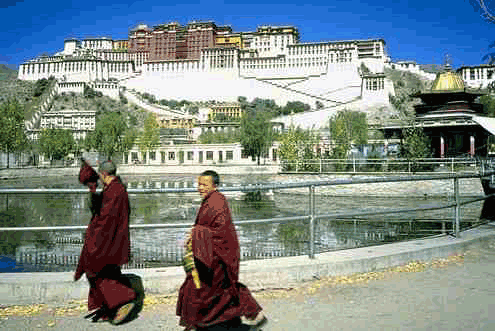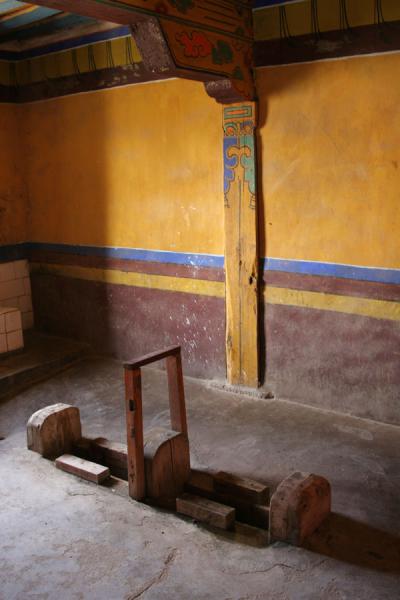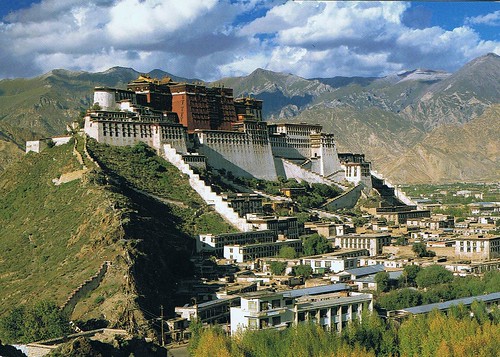The Potala Palace (Tibetan: Po-trang Po-ta-la; Chinese: Bùdála Gong) in Lhasa was the primary residence of the Dalai Lama until 1959, when the 14th Dalai Lama fled to Dharamsala after a failed uprising.
Today the Potala Palace is a state museum, a popular tourist attraction, and a UNESCO World Heritage Site. It was also recently named one of the "New Seven Wonders of the World" by the television show Good Morning America and the newspaper USA Today.
History
This hilltop site above the city of Lhasa originally hosted the meditation retreat of King Songtsen Gampo, who built the first palace there in 637 in order to greet his bride Princess Wencheng of China.
Construction of the present palace began in 1645 under the fifth Dalai Lama, Lobsang Gyatso, an important figure in Tibetan history. Known as the "Great Fifth," he unified Tibet and made the Yellow Hat sect the state religion. The White Palace was completed in 1648, after which it was used as winter quarters by the Dalai Lama.
Construction on the Red Palace was still underway when the Great Fifth died in 1682. Fearing the project would be abandoned, the monks kept his death a secret for 10 years until the Red Palace was completed. In the meantime, the Dalai Lama was impersonated by a monk who looked most like him.
In 1959, the current Dalai Lama fled to India amid riots against the Chinese military occupation of Tibet; he remains in exile today. During the Cultural Revolution (1966-77), the remaining monks were expelled and the abandoned palace was looted and damaged by Chinese soldiers.
Today, only a few monks are allowed to occupy the Potala Palace under strict supervision and Tibetan pilgrims are not generally admitted to the shrines. The Chinese government operates the palace as a state museum and has recently renovated the building to attract foreign tourists.
What to See
Built on a rocky hill overlooking the city of Lhasa, the Potala Palace has a sturdy fortress-like appearance. It contains more than a thousand rooms spreading over an area of 1,300 feet by 1,000 feet. The stone walls are 16 feet thick at the base, but more finely constructed (without the use of nails) in the upper stories.
The palace is fronted by a great plaza at the south base of the rock, enclosed by walls and gates. A series of fairly easy staircases, broken by intervals of gentle ascent, leads to the summit of the rock. It is important to become acclimated to the high altitude of Lhasa before making the climb.
The Potala Palace is made of two main parts, easily distinguished by their color: the Red Palace and White Palace. The two are joined by a smaller, yellow-painted structure that houses the sacred banners hung on the exterior for the New Year festivals. The rooms inside the palace are identified by numbers as well as names.
Red Palace
The heart of the complex is the Red Palace (Potrang Marpo), painted a deep red and used primarily for religious purposes. Richly decorated with painting, jewelled work, carving and other ornament, it contains several shrines and the tombs of eight past Dalai Lamas. Before the tombs are precious votive offerings, including a pagoda made of 200,000 pearls.
Especially celebrated throughout the Red Palace is the fifth Dalai Lama, whose life story is depicted in murals. His mummified body rests inside a 50-foot stupa covered with four tons of gold and encrusted with semi-precious stones. In another chapel he is shown enthroned as an equal to the Buddha. Also impressive is the golden tomb-stupa of the last Dalai Lama (d. 1933), who made Tibet an independent country.
The Red Palace also houses the monks' assembly hall, numerous chapels and shrines (dedicated to the full extent of Tibet's pantheon of Buddhas, bodhisattvas, saints and demons) and libraries of important Tibetan Buddhist scriptures (the Kangyur in 108 volumes and the Tengyur in 225, all hand-painted from carved wooden blocks).
White Palace
Surrounding the Red Palace is the secular White Palace (Potrang Karpo), the former home of the Dalai Lama and his monks. Originally built in the 1650s, it was extended to its present size by the 13th Dalai Lama in the early 1900s. In addition to monastic living quarters, the White Palace contained offices, the seminary for training Tibetan government officials and the printing house.
The most important shrine in the Potala is the Saint's Chapel in the White Palace, which contains a revered statue of Chenrezi, bodhisattva of compassion. Below the Saint's Chapel is the Dharma Cave, where King Songtsen Gampo studied the Buddhist scriptures after his conversion in the 7th century. These rooms are the oldest part of the Potala Palace.
Quick Facts
Site Information
Today the Potala Palace is a state museum, a popular tourist attraction, and a UNESCO World Heritage Site. It was also recently named one of the "New Seven Wonders of the World" by the television show Good Morning America and the newspaper USA Today.
History
This hilltop site above the city of Lhasa originally hosted the meditation retreat of King Songtsen Gampo, who built the first palace there in 637 in order to greet his bride Princess Wencheng of China.
Construction of the present palace began in 1645 under the fifth Dalai Lama, Lobsang Gyatso, an important figure in Tibetan history. Known as the "Great Fifth," he unified Tibet and made the Yellow Hat sect the state religion. The White Palace was completed in 1648, after which it was used as winter quarters by the Dalai Lama.
Construction on the Red Palace was still underway when the Great Fifth died in 1682. Fearing the project would be abandoned, the monks kept his death a secret for 10 years until the Red Palace was completed. In the meantime, the Dalai Lama was impersonated by a monk who looked most like him.
In 1959, the current Dalai Lama fled to India amid riots against the Chinese military occupation of Tibet; he remains in exile today. During the Cultural Revolution (1966-77), the remaining monks were expelled and the abandoned palace was looted and damaged by Chinese soldiers.
Today, only a few monks are allowed to occupy the Potala Palace under strict supervision and Tibetan pilgrims are not generally admitted to the shrines. The Chinese government operates the palace as a state museum and has recently renovated the building to attract foreign tourists.
What to See
Built on a rocky hill overlooking the city of Lhasa, the Potala Palace has a sturdy fortress-like appearance. It contains more than a thousand rooms spreading over an area of 1,300 feet by 1,000 feet. The stone walls are 16 feet thick at the base, but more finely constructed (without the use of nails) in the upper stories.
The palace is fronted by a great plaza at the south base of the rock, enclosed by walls and gates. A series of fairly easy staircases, broken by intervals of gentle ascent, leads to the summit of the rock. It is important to become acclimated to the high altitude of Lhasa before making the climb.
The Potala Palace is made of two main parts, easily distinguished by their color: the Red Palace and White Palace. The two are joined by a smaller, yellow-painted structure that houses the sacred banners hung on the exterior for the New Year festivals. The rooms inside the palace are identified by numbers as well as names.
Red Palace
The heart of the complex is the Red Palace (Potrang Marpo), painted a deep red and used primarily for religious purposes. Richly decorated with painting, jewelled work, carving and other ornament, it contains several shrines and the tombs of eight past Dalai Lamas. Before the tombs are precious votive offerings, including a pagoda made of 200,000 pearls.
Especially celebrated throughout the Red Palace is the fifth Dalai Lama, whose life story is depicted in murals. His mummified body rests inside a 50-foot stupa covered with four tons of gold and encrusted with semi-precious stones. In another chapel he is shown enthroned as an equal to the Buddha. Also impressive is the golden tomb-stupa of the last Dalai Lama (d. 1933), who made Tibet an independent country.
The Red Palace also houses the monks' assembly hall, numerous chapels and shrines (dedicated to the full extent of Tibet's pantheon of Buddhas, bodhisattvas, saints and demons) and libraries of important Tibetan Buddhist scriptures (the Kangyur in 108 volumes and the Tengyur in 225, all hand-painted from carved wooden blocks).
White Palace
Surrounding the Red Palace is the secular White Palace (Potrang Karpo), the former home of the Dalai Lama and his monks. Originally built in the 1650s, it was extended to its present size by the 13th Dalai Lama in the early 1900s. In addition to monastic living quarters, the White Palace contained offices, the seminary for training Tibetan government officials and the printing house.
The most important shrine in the Potala is the Saint's Chapel in the White Palace, which contains a revered statue of Chenrezi, bodhisattva of compassion. Below the Saint's Chapel is the Dharma Cave, where King Songtsen Gampo studied the Buddhist scriptures after his conversion in the 7th century. These rooms are the oldest part of the Potala Palace.
Quick Facts
Site Information
- Names: Potala Palace; Bùdála Gong
- Location: Lhasa, Tibet
- Faith: Buddhism
- Denomination: Tibetan
- Order: Yellow Hat
- Categories: Castles and Palaces; Buddhist Monasteries; World Heritage Sites
- Date: Founded 637; present building mostly 17th cent.
- Status: museum
- Coordinates: 29.657715° N, 91.117233° E (view on Google Maps)
- Lodging: View hotels near this location
- Phone: 0891/683-4362
- Opening hours: 9am-3pm daily. Admission is limited to 2,500 visitors per day. Reservations must be made a few hours to one day in advance. Entry time is assigned when the ticket is purchased.
- Cost: General admission ¥100; admission to relics museum and roof additional ¥10 each



 9:01 AM
9:01 AM
 crkota
crkota

























 Posted in:
Posted in: 




1 comments:
People always want to go at best place where they can enjoy beautiful location and like to stay in good palace.
Post a Comment